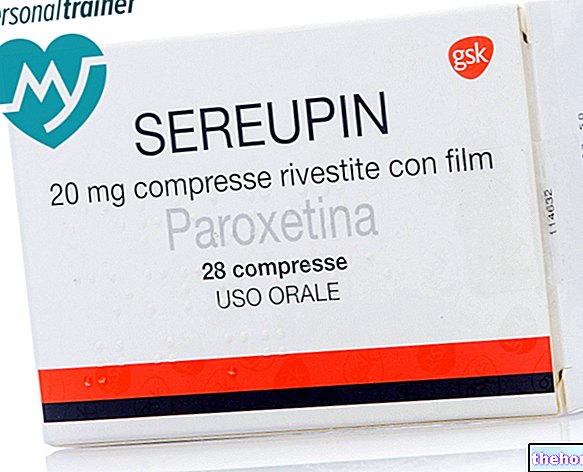Active ingredients: Granisetron
Granisetron Sandoz 1 mg / ml concentrate for solution for injection or infusion
Why is Granisetron - Generic Drug used? What is it for?
Granisetron Sandoz belongs to a group of medicines called antiemetics. It is used to prevent or treat nausea and vomiting caused by other medical treatments, such as chemotherapy or radiation therapy for a tumor, and by surgery.
The solution for injection should be used in adults and children from two years of age.
Contraindications When Granisetron - Generic Drug should not be used
Do not take Granisetron Sandoz
if you are allergic to granisetron or any of the other ingredients of this medicine
If you are not sure, talk to your doctor, nurse or pharmacist before having the injection.
Precautions for use What you need to know before taking Granisetron - Generic Drug
Tell your doctor, nurse or pharmacist before having the injection
- if, due to an intestinal blockage, you suffer from problems related to bowel movements
- if you have heart problems, are being treated for cancer with a medicine known to harm your heart or have problems with salt levels such as potassium, sodium or calcium (electrolyte changes)
- if you are taking other 5-HT3 receptor antagonist medicines. These include dolasetron and ondansetron, used like Granisetron Sandoz in the treatment and prevention of nausea and vomiting.
Interactions Which drugs or foods may change the effect of Granisetron - Generic Drug
Tell your doctor, nurse or pharmacist if you are taking, have recently taken or might take any other medicines. This is because Granisetron Sandoz can affect the way some medicines work. Also, some medicines may also affect the effectiveness of this injection.
In particular, tell your doctor, nurse or pharmacist if you are taking the following medicines:
- medicines used to treat irregular heartbeat
- other 5-HT3 receptor antagonist medicines, such as dolasetron or ondansetron (see "Warnings and precautions" above)
- phenobarbital, a medicine used to treat epilepsy
- a medicine called ketoconazole, used to treat fungal infections
- the antibiotic erythromycin, used to treat bacterial infections.
Warnings It is important to know that:
Pregnancy and breastfeeding
If you are pregnant, planning to become pregnant or are breast-feeding, you should not receive this injection unless specifically directed by your doctor.
If you are pregnant, think you may be pregnant or are planning to have a baby, or if you are breast-feeding, ask your doctor, nurse or pharmacist for advice before using any medicine.
Driving and using machines
Granisetron Sandoz has little or no effect on the ability to drive or use machines.
Granisetron Sandoz contains sodium
This medicinal product contains 1.4 mmol (31.5 mg) of sodium per maximum daily dose (9 mg of granisetron). This should be taken into consideration in patients on a controlled sodium diet.
Dose, Method and Time of Administration How to use Granisetron - Generic Drug: Posology
The injection will be given to you by a doctor or nurse. The dosage of Granisetron Sandoz varies from patient to patient and depends on age, weight and indication (and whether you receive the medicine for prevention or for treatment of nausea and vomiting). Your doctor will work out the right dosage for you.
Granisetron Sandoz can be given as an injection into a vein (intravenously).
Prevention of nausea or vomiting induced by radio- or chemotherapy
The injection will be given to you before the start of radio- or chemotherapy. Injection into a vein takes between 30 seconds and 5 minutes and usually the dosage is between 1 and 3 mg. The medicine can be diluted before being injected.
Treatment of nausea or vomiting induced by radio- or chemotherapy
The injection takes between 30 seconds and 5 minutes and usually the dosage is between 1 and 3 mg. The medicine can be diluted before being injected into a vein. After the first dose is given, in order to prevent the nausea / vomiting, you may receive more injections. It will take at least 10 minutes between each injection. The maximum dose of Granisetron Sandoz you can receive in one day is 9 mg.
Combination with steroids
The effect of the injection can be enhanced by the use of medicines called adrenocortical steroids. The steroid will be given to you as a dose of dexamethasone between 8 and 20 mg before radio- or chemotherapy, or as 250 mg. of methylprednisolone, which will be given to you both before and after radio- or chemotherapy.
Use in children for the prevention or treatment of nausea or vomiting induced by radio- or chemotherapy
Children receive Granisetron Sandoz in the form of injections into a vein, as described above, the dosage of which depends on the weight of the child. The injections are diluted and given before radio- or chemotherapy, over 5 minutes. Children can receive a maximum of 2 doses per day, at least 10 minutes apart.
Treatment of nausea or vomiting after surgery
Injection into a vein takes between 30 seconds and 5 minutes and the dose is usually 1 mg. The maximum dose of Granisetron Sandoz you can receive in one day is 3 mg.
Use in children for the prevention or treatment of nausea or vomiting after surgery
Children should not receive this injection for the treatment of nausea or vomiting after surgery.
Overdose What to do if you have taken an overdose of Granisetron - Generic Drug
If you are given too much Granisetron Sandoz As the injection will be given to you by a doctor or nurse, it is unlikely that you will get too much of this medicine. However, if you are concerned, consult your doctor or nurse. Symptoms of overdose include mild headaches. Treatment of any overdose will depend on the symptoms. If you have any further questions on the use of this medicine, ask your doctor, nurse or pharmacist.
Side Effects What are the side effects of Granisetron - Generic Drug
Like all medicines, this medicine can cause side effects, although not everybody gets them.
If you experience any of the following symptoms, tell your doctor immediately:
- allergic reactions (anaphylaxis). The signs may include swelling of the throat, face, lips and mouth, difficulty in breathing or swallowing.
Other side effects that may occur while taking this medicine are:
Very common (may affect more than 1 in 10 people):
- headache
- constipation. Your doctor will keep you under observation.
Common (may affect up to 1 in 10 people):
- sleep disturbances (insomnia)
- changes in liver function shown in blood tests
- diarrhea.
Uncommon (may affect up to 1 in 100 people)
- rash, or an allergic skin reaction, or hives. The signs may include red, raised, itchy bumps
- changes in the heartbeat (rhythm) and changes in the heart seen by reading the ECG (recording of the electrical activity of the heart)
- abnormal involuntary movements, such as tremor, muscle stiffness and muscle twitching.
Reporting of side effects
If you get any side effects, talk to your doctor or pharmacist or nurse. This includes any possible side effects not listed in this leaflet. You can also report side effects directly via the national reporting system at www.agenziafarmaco.it/it. / responsible. By reporting side effects you can help provide more information on the safety of this medicine.
Expiry and Retention
Keep this medicine out of the sight and reach of children.
Do not use Granisetron Sandoz after the expiry date which is stated on the vial and carton after EXP. The expiry date refers to the last day of the month.
Keep the vial in the outer carton to protect the medicine from light.
Do not freeze.
Diluted solution
Chemical and physical in-use stability has been demonstrated for 24 hours at 25 ° C. From a microbiological point of view the medicinal product should be used immediately.
Do not throw any medicines via wastewater or household waste. Ask your pharmacist how to throw away medicines you no longer use. This will help protect the environment.
Other Information
What Granisetron Sandoz contains
- The active ingredient is granisetron (in the form of hydrochloride).
- Each vial of 1 ml of concentrate for solution for injection or infusion contains granisetron hydrochloride equivalent to 1 mg of granisetron.
- Each vial of 3 ml of concentrate for solution for injection or infusion contains granisetron hydrochloride equivalent to 3 mg of granisetron.
- The other ingredients are citric acid monohydrate, sodium chloride, sodium hydroxide (for pH adjustment), hydrochloric acid (for pH adjustment) and water for injections.
What Granisetron Sandoz looks like and contents of the pack
Granisetron Sandoz is a concentrate for solution for injection or infusion. The solution is clear, colorless or pale yellow.
- 1 ml of concentrate for solution for injection or infusion is contained in a 2 ml type I clear glass vial with a 13 mm rubber stopper and an aluminum seal with a dark blue flip-off disc.
- Pack sizes: 1 and 5 vials.
- 3 ml of concentrate for solution for injection or infusion is contained in a 5 ml type I clear glass vial, with a 13 mm rubber stopper and aluminum seal with dark blue flip-off disc or in a clear glass vial type 1 x 6ml, with 20mm rubber stopper and aluminum seal with dark blue flip-off disc. - Pack sizes: 1, 5 and 10 vials.
Source Package Leaflet: AIFA (Italian Medicines Agency). Content published in January 2016. The information present may not be up-to-date.
To have access to the most up-to-date version, it is advisable to access the AIFA (Italian Medicines Agency) website. Disclaimer and useful information.
01.0 NAME OF THE MEDICINAL PRODUCT
GRANISETRON SANDOZ 1 MG / ML CONCENTRATE FOR SOLUTION FOR INJECTION OR FOR INFUSION
02.0 QUALITATIVE AND QUANTITATIVE COMPOSITION
Each vial of 1 ml of concentrate for solution for injection or infusion contains granisetron hydrochloride equivalent to 1 mg of granisetron.
Each vial of 3 ml of concentrate for solution for injection or infusion contains granisetron hydrochloride equivalent to 3 mg of granisetron.
Excipient (s) with known effect: sodium
For the full list of excipients, see section 6.1.
03.0 PHARMACEUTICAL FORM
Concentrate for solution for injection or infusion.
Clear, colorless or pale yellow solution, with pH between 4.0 or 6.0.
04.0 CLINICAL INFORMATION
04.1 Therapeutic indications
Prevention or treatment of acute episodes of nausea and vomiting induced by cytostatic therapy (chemotherapy or radiotherapy).
Additional indications for granisetron 1 ml vial:
Prevention and treatment of post-operative nausea and vomiting.
04.2 Posology and method of administration
Cytostatic therapy
Adults
A single dose of 1 mg granisetron is recommended for the prevention or treatment of nausea and vomiting induced by cytostatic therapy. A single 3 mg dose may be preferable in some patients.
A single dose of 3 mg granisetron is recommended for the prevention or treatment of radiotherapy induced nausea and vomiting.
Granisetron Sandoz should only be administered intravenously. Granisetron 1 mg or 3 mg should be administered or as an intravenous bolus in 5 or 15 ml of solution for infusion over a period of not less than 30 seconds or diluted in 20-50 ml of solution for infusion and administered over five minutes.
Prevention: In clinical trials, most patients required only a single dose of granisetron to control nausea and vomiting within 24 hours. Up to two further doses of granisetron may be given within a 24 hour period. There is clinical experience in patients who have received daily administrations for up to five consecutive days in a single course of therapy. Prophylactic administration of granisetron should be completed prior to the initiation of cytostatic therapy.
Treatment: The same dose used for prevention should be used for treatment. Any further doses should be administered at least 10 minutes apart.
Maximum daily dose: Up to 3 doses of 3 mg granisetron can be administered over a 24 hour period. The maximum dose of granisetron administered per 24 hours should therefore not exceed 9 mg.
Concomitant use of dexamethasone: The efficacy of granisetron can be increased by adding dexamethasone.
Pediatric population
Children aged 2 years and adolescents
Prevention: In children weighing up to 25 kg a single dose of 40 micrograms / kg is recommended. A single dose of 1 mg granisetron is recommended for children weighing ≥25 kg. A single 3 mg dose may be preferable in some patients. Granisetron, diluted in 10-30 ml of solution for infusion, should be administered over five minutes by intravenous infusion. Administration should be completed prior to the start of cytostatic therapy.
Treatment: The same dose used for prevention should be used for treatment. If necessary, an additional dose of 40 mcg / kg body weight (up to a maximum of 3 mg) can be administered over a 24-hour period. This supplemental dose should be administered at least 10 minutes after the initial infusion.
Children under 2 years of age :
Granisetron should not be used in children below 2 years of age because insufficient data are available.
Senior citizens
In the case of elderly patients no dosage adjustments are required.
Patients with renal or hepatic impairment
In the case of patients with renal or hepatic impairment no dosage adjustments are required.
Post-operative nausea and vomiting
Only applicable for granisetron 1 mg vials (see section 4.1)
Adults
For prevention in adults, a single 1 mg dose of granisetron should be diluted to 5 ml and administered by slow intravenous injection (over 30 seconds). Administration should be completed prior to induction of anesthesia.
For the treatment of post-operative nausea and vomiting in adults a single 1 mg dose of granisetron should be diluted to 5 ml and administered by slow intravenous injection (over 30 seconds).
Maximum dose and duration of treatment
Two doses (2 mg) in one day.
Pediatric population
There is no experience with the use of granisetron for the prevention and treatment of post-operative nausea and vomiting in children. Therefore, granisetron is not recommended for the treatment of post-operative nausea and vomiting for this age group.
Senior citizens
As for adults
Patients with renal or hepatic impairment
As for adults.
04.3 Contraindications
Hypersensitivity to granisetron, related substances or to any of the excipients (see section 6.1).
04.4 Special warnings and appropriate precautions for use
Since granisetron is capable of reducing lower bowel motility, patients with signs of sub-acute intestinal obstruction should be carefully monitored after administration of the medicinal product.
As with other 5-HT3 receptor antagonists, granisetron has been reported to cause ECG changes including QT interval prolongation. In patients with pre-existing arrhythmias or cardiac conduction disturbances this can lead to clinical consequences. Therefore, caution should be exercised in patients with cardiac co-morbidities, with cardiotoxic chemotherapy and / or with concomitant electrolyte disturbances (see section 4.5).
Cross-sensitivity has been reported among 5-HT3 antagonists (e.g. dolasteron, ondansetron).
Pediatric population
There is no experience with the use of this medicine in children under 2 years of age.
Excipient with known effect
This medicinal product contains 1.4 mmol (31.5 mg) of sodium per maximum daily dose (9 mg of granisetron). This should be taken into consideration in patients on a controlled sodium diet.
04.5 Interactions with other medicinal products and other forms of interaction
Animal studies indicate that granisetron does not stimulate or inhibit the cytochrome P-450 enzyme system.
Since granisetron is metabolised by hepatic cytochrome P-450 metabolising enzymes, the use of inducers or inhibitors of these enzymes could alter the clearance and, consequently, the half-life of granisetron.
In humans, induction of liver enzymes by phenobarbital resulted in an increase (approximately 25%) in the total plasma clearance of granisetron administered intravenously.
As with other 5-HT3 receptor antagonists, granisetron has been reported to cause ECG changes including QT interval prolongation. In patients treated concomitantly with medicinal products known to prolong the QT interval and / or to cause arrhythmias, serious clinical consequences may occur (see section 4.4). In studies in healthy subjects, no evidence of any interaction between granisetron and benzodiazepines (lorazepam), neuroleptics (haloperidol) or anti-ulcer medicines (cimetidine) Furthermore, granisetron has not shown any obvious interaction with medicines for emetogenic chemotherapy used against cancer.
No specific interaction studies have been conducted in anesthetized patients, but granisetron has been safely administered together with commonly used anesthetics and analgesic agents.
Education in vitro demonstrated that ketoconazole could inhibit the metabolism of granisetron by the cytochrome P-450 3A family of isoenzymes. The clinical significance of this phenomenon is unknown.
04.6 Pregnancy and breastfeeding
Pregnancy
There are limited data on the use of granisetron in pregnant women. Animal studies do not indicate any direct or indirect harmful effects with respect to reproductive toxicity (see section 5.3). As a precautionary measure, it is preferable to avoid the use of granisetron during pregnancy.
Feeding time
It is unknown whether granisetron or its metabolites are excreted in human milk. As a precaution, breastfeeding is not recommended during treatment with granisetron.
Fertility
In rats, granisetron had no harmful effects on reproductive capacity or fertility.
04.7 Effects on ability to drive and use machines
Granisetron has no or negligible influence on the ability to drive and use machines.
04.8 Undesirable effects
Summary of the safety profile
Common adverse reactions reported for granisetron are headache and constipation, which may be transient. ECG changes, including QT interval prolongation, have been reported with granisetron (see sections 4.4 and 4.5).
Table of adverse reactions
The following table of adverse reactions is based on clinical studies and post-marketing data associated with granisetron and other 5-HT3 antagonists.
The categories of attendance are as follows:
very common (≥1 / 10); common (≥1 / 100 to
* Occurred at a similar frequency in patients treated with comparator therapy
Description of selected adverse reactions
As with other 5-HT3 antagonists, ECG changes including QT interval prolongation have been reported with granisetron (see sections 4.4 and 4.5).
Reporting of suspected adverse reactions
Reporting of suspected adverse reactions occurring after authorization of the medicinal product is important as it allows continuous monitoring of the benefit / risk balance of the medicinal product. Healthcare professionals are asked to report any suspected adverse reactions via the national reporting system. "address www.agenziafarmaco.gov.it/it/responsabili.
04.9 Overdose
There is no specific antidote for granisetron. In case of tablet overdose, symptomatic treatment is indicated. Headache has been reported, but no further sequelae have been observed following administration of doses up to 38.5 mg of granisetron in a single injection.
05.0 PHARMACOLOGICAL PROPERTIES
05.1 Pharmacodynamic properties
Pharmacotherapeutic group: antiemetics and antinauseants, serotonin (5-HT3) antagonists.
ATC code: A04AA02.
Granisetron is a potent antiemetic and highly selective 5-hydroxy-tryptamine (HT3) receptor antagonist. Studies with radioactive ligands have shown that granisetron has negligible affinity for other types of receptors, including the binding sites of other types of 5HT and dopamine D2 receptors.
Granisetron is effective intravenously, both for prophylaxis and for intervention, in the suppression of retching and vomiting induced by the administration of cytotoxic drugs or by irradiation of the whole body by X-rays.
Administered intravenously, granisetron is effective in the prevention and treatment of post-operative nausea and vomiting.
05.2 Pharmacokinetic properties
General features
Distribution
Granisetron is distributed extensively, with a mean volume of distribution of approximately 3 l / kg; plasma protein binding is approximately 65%.
Biotransformation
Biotransformation pathways include N-demethylation and oxidation of the aromatic ring, followed by conjugation.
Elimination
Clearance occurs predominantly via hepatic metabolism. The urinary excretion of unchanged granisetron corresponds on average to 12% of the dose, while that of metabolites corresponds to approximately 47% of the dose. The remainder is excreted in the faeces as metabolites. The mean plasma half-life is approximately 9 hours. with a "wide intra-individual variability.
Characteristics in patients
The plasma concentration of granisetron is not clearly related to antiemetic efficacy. Clinical benefits may exist even when granisetron is not identified in plasma.
After administration of single intravenous doses, the pharmacokinetic parameters in elderly subjects were within the range found in non-elderly subjects. In patients with severe renal insufficiency the data indicate that following administration of a single intravenous dose , the pharmacokinetic parameters are generally similar to those seen in normal subjects. In patients with hepatic impairment due to liver cancer, total plasma clearance after a single intravenous dose was approximately half that in non-affected subjects. However, despite these differences, no dosage adjustments are required in these patients.
05.3 Preclinical safety data
Preclinical data did not reveal any particular danger to humans, based on conventional studies of safety pharmacology, repeated dose toxicity, reproductive toxicity and genotoxicity. Carcinogenicity studies did not reveal any particular hazard to humans when granisetron was used at recommended doses. However, when granisetron is administered at higher doses and for an extended period of time, a risk of carcinogenicity cannot be excluded.
Regarding the safety pharmacology, a study in cloned human cardiac ion channels demonstrated that granisetron has the potential to affect cardiac repolarization by blocking HERG potassium channels. Granisetron has been shown to block both sodium and potassium channels, which could potentially compromise both depolarization and repolarization by prolonging the PR, QRS and QT intervals. These data help to clarify the molecular mechanisms due to which some of the alterations to the ECG (in particular the prolongation of the QT and QRS intervals) associated with this class of agents occur. However, changes in heart rate, blood pressure do not occur. or the ECG trace; even if these should occur, these are generally alterations of no clinical significance.
06.0 PHARMACEUTICAL INFORMATION
06.1 Excipients
Citric acid monohydrate
Sodium chloride
Sodium hydroxide (for pH adjustment)
Hydrochloric acid (for pH adjustment)
Water for injections
06.2 Incompatibility
This medicinal product must not be mixed with other medicinal products except those mentioned in section 6.6.
Prophylactic administration of Granisetron Sandoz must be completed prior to the initiation of cytostatic therapy.
06.3 Period of validity
2 years.
After dilution: Chemical and physical in-use stability has been demonstrated for 24 hours at 25 ° C. From a microbiological point of view the medicinal product should be used immediately.
06.4 Special precautions for storage
Keep the vial in the outer carton to protect the medicine from light.
Do not freeze.
For storage conditions of the diluted medicinal product, see section 6.3.
06.5 Nature of the immediate packaging and contents of the package
- 2 ml type I clear glass vial with 13 mm rubber stopper and aluminum seal with disc flip-off dark blue (per 1 ml of concentrate for solution for injection or infusion).
- 5 ml type I clear glass vial with 13 mm rubber stopper and aluminum seal with disc flip-off dark blue (for 3 ml of concentrate for solution for injection or infusion).
- 6 ml type I clear glass vial with 20 mm rubber stopper and aluminum seal with disc flip-off dark blue (for 3 ml of concentrate for solution for injection or infusion).
Packs:
1 ml of concentrate for solution for injection or infusion: 1 and 5 vials.
3 ml of concentrate for solution for injection or infusion: 1, 5 and 10 vials.
Not all pack sizes may be marketed.
06.6 Instructions for use and handling
Dilute before use. For single use only. Remaining amount of unused medicine should be discarded.
Granisetron Sandoz injections and intravenous infusions must be prepared at the time of administration and used immediately from a microbiological point of view. In-use storage times and conditions prior to use are not supported by microbiological data and are therefore the responsibility of the user (see section 6.3).
Diluted injections and infusions should be checked visually for the presence of particulates prior to administration and should only be used if the solution is clear and free of particles.
Preparation of the injection
Adults: To prepare a 1 mg dose, withdraw 1 ml from the vial and dilute to 5 ml with sodium chloride injection BP 0.9% w / v.
To prepare a 3 mg dose, withdraw 3 ml from the vial and dilute to 15 ml with 0.9% w / v sodium chloride injection BP (for bolus administrations).
Preparation of the infusion
Adults : To prepare a 1 mg or 3 mg dose, withdraw 1 ml or 3 ml from the vial and dilute in a solution for infusion to a total volume of 20 to 50 ml in any of the following solutions: sodium chloride injection BP 0, 9% w / v; sodium chloride 0.18% w / v and glucose injection BP 4% w / v; injectable glucose BP 5% w / v; Hartmann's solution for injection BP; injectable sodium lactate BP; or 10% BP injectable mannitol. No other diluent should be used.
Pediatric population
To prepare a 40 mcg / kg dose, withdraw the appropriate volume (up to 3 ml) from the vial and dilute with a solution for infusion (as for adults) to a total volume between 10 and 30 ml.
Any unused quantities of medicine and any waste material should be disposed of in accordance with local laws.
07.0 MARKETING AUTHORIZATION HOLDER
Sandoz S.p.A. - Largo U. Boccioni, 1 - 21040 Origgio (VA)
08.0 MARKETING AUTHORIZATION NUMBER
1 mg / ml concentrate for solution for injection or infusion 1 vial of 1 ml - AIC n. 039723010
1 mg / ml concentrate for solution for injection or infusion 5 vials of 1 ml - AIC n. 039723022
1 mg / ml concentrate for solution for injection or infusion 1 vial of 3 ml - AIC n. 039723034
1 mg / ml concentrate for solution for injection or infusion 5 vials of 3 ml - AIC n. 039723046
1 mg / ml concentrate for solution for injection or infusion 10 vials of 3 ml - AIC n. 039723059
09.0 DATE OF FIRST AUTHORIZATION OR RENEWAL OF THE AUTHORIZATION
30/08/2010
10.0 DATE OF REVISION OF THE TEXT
October 2013




























